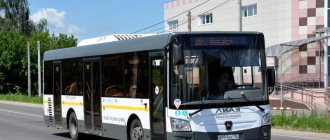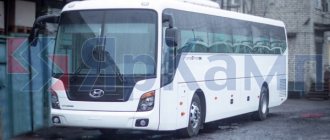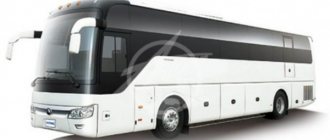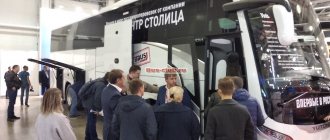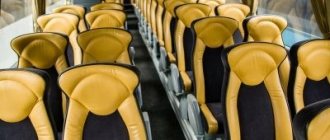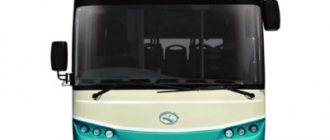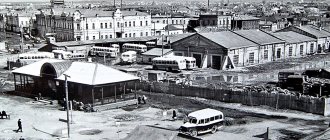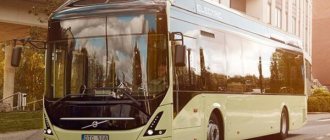"Bus" redirects here. For other uses, see Bus (disambiguation).
Single decker bus from London, England, UK, operated by Metroline. The Alexander Dennis Enviro 400 bus, owned by Arriva, is a double-decker bus. Transmetro bi-articulated transport system in Guatemala City, Guatemala. A double-articulated TransMilenio bus in Bogotá, Colombia. Transantiago articulated bus in Chile. Several intercity buses from Catalonia at Granollers Station in Spain. Metrobus system in Caracas, Venezuela. Here we see the Iveco Daily Irisbus minibus. service on line 21 Guagua de Villajoyosa.
Bus, coach
, route
,
collective
,
fleet
,
bondi
,
guagua
,
micro
, villavesa or
omnibus (see section
"Regionalisms") is a vehicle designed to transport large numbers of people on urban roads. It is usually used in urban and intercity public transport and with a fixed route. Its capacity can vary from 10 to 120 passengers. In bus rapid transit systems, bus capacity can range from 160 to 240 passengers.
Etymology
Gasoline-Oscar, 1895
Bus
is apheresis from the Greek word
autos
and the Latin
word omnibús
.
Omnibus
comes from the owner of a hat shop,
Monsieur
Omnes, who named his shop Omnes Omnibus as a play on words.
The hat shop was located in front of one of the first carriage stations in Nantes (France) in 1823. Omnès is the Latin sound of omnes,
meaning “all,” and
omnibus,
“for all.”
The people of Nantes soon after gave the vehicle the nickname omnibus.
When horse-drawn transport was motorized, from 1905 the bus was called
a coach,
a term which, like
coach,
is still in use today. [ 1 ]
regionalisms
Names used for buses based on their capacity and function in the Spanish-speaking world.
A 1920 bus in Cúcuta, Colombia. Municipal bus in Las Palmas de Gran Canaria, Spain. City bus of the city of Granada, Nicaragua. Collective from the city of Paraná, Argentina. Urban transport of the city of Villa Nueva, Guatemala.
| Region | Names |
| Central America | Bus |
| Argentina | Colectivo , bondi (very colloquial, city travel), ómnibus , micro (intercity; "micro" is an apocope of microómnibus and was originally used for small city buses, the word is now commonly used for large intercity buses, mainly in Buenos Aires) . "Micro" is the common name for urban transport in the Cuyo region. |
| Bolivia | Fleet , bus , bus and omnibus (for travel and tourism), collective , gondola (school bus), micro (for urban transport), minibus or microbus (for urban excursion vans), coaster , truffi taxi (for passenger cars or vans that do utilities in the neighborhood) |
| Chile | (la) Micro (often some people turn the word around and say (la) Cromi ), hare (for small buses only), bus (for intercity travel), taxi (in Concepción), accordion or Cuncuna (for Transantiago articulated buses) |
| Colombia | Bus , buseta , colectivo , bus , chiva , car park (for intermunicipal trips) |
| Costa Rica | Bus , bus , minibus , minibus , chivilla , jacket , bank |
| Cuba | Guagua , bus , yutong |
| Ecuador | bus , minibus , team |
| Savior | Minibus , bus , coaster , small bus |
| Spain | Bus , line coach, coach , bus or line car (general). Van (Huelva and south of Madrid), ladies (Huelva and Seville), socibus (bus operating on the Madrid-Andalusia route), Valenciana and eats (Jerez de la Frontera for intercity buses), eats (in Cadiz, on intercity bus), micro (small buses), mini and microbuses (small buses designed for streets where a regular bus cannot travel), villavesa (Pamplona), city (Vitoria), Tuza (Badalona, Santa Coloma de Gramenet and Sant'Adria de Besos), carraca (Buen Pastor, Milans del Bosch and Baron de Viver, Barcelona), Alsa (Asturias, Cantabria and Leon), COA (Melilla), blasa (Alcorcón, Móstoles and Villaviciosa de Odón), trolleybus (Pontevedra), truck (Málaga), alsina (Granada, Pava (Jaén) and some areas of Lleida), guagua (Canarias, Puerto Real and Villajoyosa), bus (Barcelona), Vitrasa (city buses from Vigo), Hardiner (internal airport buses that transport passengers from terminals to aircraft). and vice versa), autedia (Comarca de Guadix), salcai or utinsa (south or north of Gran Canaria, respectively), talesa (Extremadura), cooperative (Aljarafe), it is also called postal (in the province of Almeria, since in the 1960s In the 1970s and 1970s, it was on buses that letters from the Postal Service, formerly owned by the state, traveled). |
| Guatemala | Truck , bus , donkey , bus |
| Honduras | bus , bus |
| Mexico | Truck , micro (female in some parts of Mexico City), pesero or kamikaze (if it's a combo), chat , chimeko , donkey , guajolotero (to buses that go from city to city), totolero (if it is a very old bus), metrobus (articulated), route , caterpillar (before articulated in León, Guanajuato), route In Baja California bus , |
| Nicaragua | Bus , minibus , minibus , minibus (if it is small) |
| Panama | Bus , chiva , bus , red devil (very colloquial), metrobus (new to the system, which is on shift) |
| Peru | Ómnibus , bus , Mirabús (double-decker buses for tourism) micro , car , cúster, combi, colectivo (the last two are among the smallest) |
| Paraguay | Micro , collective , bus |
| Puerto Rico | Guagua , pisicorre (small bus) |
| Dominican Republic | Guagua , bus |
| Uruguay | Buses (all: city, interdepartmental and international) and bondi (slang) |
| Venezuela | Bus , coach (large), autobusete , buseta , minibus , van , burro (large bus) * , burra (buseta or short bus) * , Expresos (double-decker bus) * , truck , route (minibuses), collective (usually belonging to which or transport company used for long trips), Yutong (refers to units belonging to the Chinese bus brand, due to the phenomenon of brand vulgarization). It is little used in the state of Portuguesa. |
Bus body component
The structure of the bus body is divided into several related and complementary parts:
- Frame. In fact, it plays the role of a skeleton onto which the remaining components are subsequently hung. The main task of engineers is to find a compromise between design safety, weight reduction and increased load capacity. The standard solution is the use of pipe or rolled metal products. Body elements are welded together in predetermined proportions. The entire structure can be divided into base, roof, sides, front and rear.
- Internal and external lining. On the outside of the bus, stamped sheets of metal or aluminum are used to “sheath” the frame of the building. Inside there are panels made of fiberboard or wood.
- Floor. In order to reduce the overall weight of the structure, wooden panels covered with rubber or rubberized carpet are used.
- Window. They can be “deaf” or equipped with opening windows. It is important to understand that the windows on the bus also serve as an emergency exit in case of an accident or fire, when the bus doors remain locked.
- Doors. They can be single-leaf, double-leaf or sliding, depending on the brand and type of vehicle.
The interior structure of the cabin is changing. It affects the location of the seats, the maximum capacity and depends on the specific purpose of the bus (minibus) model.
bus dimensions
Comparison of bus sizes [2]
| Vehicle | Length in meters | Seating | total maximum power | Engine position * |
| Minibus | 4,5-6,0 | 10-12 | 12 | frontal |
| minibus | 6,0-7,5 | 12-15 | 15 | frontal |
| minibus | 8,0-10,5 | 16-30 | 30 | rear |
| standard bus | 10.6-12 | 31-120 | 120 | rear |
*Does not apply to all models
Characteristics of Buses.
A promising single large-class city bus should have:
— nominal capacity (q vm) of at least 90 people;
— diesel engine with horizontal cylinders;
— two storage areas and three (1200 mm) wide double-leaf swing doors;
— with overhang angles of at least 9 degrees;
— ground clearance 200-210 mm.
There are also middle-class city buses with a capacity of 60-70 people. And a particularly large class for 110-125 people, with three storage areas and four double doors.
2. A commuter bus can no longer be a modification of a city bus and must be an independent basic model (overhang angles of at least 11 degrees and ground clearance of 240 mm). A type of commuter bus has been introduced with
the presence of two doors with a width of 830 mm, and it is desirable to have buses of two classes: medium (with a capacity of 60-65 people with 30-35 seats) and large (with a capacity of 75-85 people with 45-50 seats).
3. Buses for serving the rural population (PAZ-672, PAZ-3021, KAVZ-685) cannot be successfully operated in rural areas; they have low cross-country ability, narrow doors, rigid suspension, and no conditions for carrying luggage.
types of buses
minibus
Minibus or microbus
in Valparaiso, Chile.
Main article: Minibus
Also known as minibus and buseta, it is a small bus with a capacity of 8 to 30 passengers.
minibus
Main article: Midibus
A medium bus between a minibus and a coach, which is between 8 and 10.5 meters in length and is designed to carry 60 to 80 passengers sitting and standing.
articulated bus
An articulated city bus, operated by EMT Madrid.
Main article: Articulated bus
A bus with two or more sectional type modules.
Two fold car
Main article: Double-decker bus
Double decker bus, Ayutthaya, Thailand.
Very typical of urban and suburban transport in the British Commonwealth.
School bus
Main article: School bus
These buses are used to transport children to school.
Trainer
Main article: Coach
A large-capacity vehicle for long-distance or long-distance passenger transport.
Trolleybus
Trolleybus line k in Rosario, Argentina.
Main article: Trolleybus
An electric traction bus without rails that draws its current from an overhead line using a double bogie.
rail bus
Main article: Rail bus
An ultra-light rail vehicle, usually on a conventional or modified bus chassis.
tourist tram
Main article: Tourist tram
A tourist tram or tourist trolley, also called a tourist bus, is actually a rubber-tired minibus, usually powered by diesel, sometimes compressed natural gas, and resembling an old-style tram.
Chiva
Goat .
_ Main article: Chiva (car)
Chivas are typical buses from Colombia, Ecuador and Panama, artisanally adapted for rural public transport, especially given the mountainous geography of the Andean region. They are distinguished by the fact that they are very colorful and decorated. There is a shelf at the top used for carrying luggage.
Types and brands of buses
Since its invention, the bus has become firmly established in city life. Buses are divided into classes based on capacity, which are determined by the length of the vehicle itself. There are especially small buses with a length of less than 5 meters, small (5-8 m) and medium ones, the length of which varies from 8 to 10 meters.
The most popular are city buses. By the way, these include large 10-15-meter and especially large (more than 15 meters) classes of buses. This type of vehicle is intended for transporting passengers within the city. During peak hours, articulated buses (accordion) help out, the passenger capacity of which is much greater than that of ordinary city buses. Also, for greater convenience for passengers, manufacturers of this type of equipment have launched the production of low-floor models.
School buses are becoming increasingly popular in Russia every year. They differ fundamentally from urban ones by installing additional light signals and large mirrors that increase visibility. Manufacturers of this type of vehicle are also required to install seat belts on each seat for children.
At first glance, suburban and intercity buses are quite similar, but there are still differences. First of all, they relate to the degree of passenger comfort. If, for example, suburban buses often have seats of the “city route” type, then intercity buses have softer, more comfortable seats with a high back. In addition, long-distance vehicles can boast of a small luggage compartment. In suburban buses, such a pleasure is only available in the form of shelves for hand luggage in the cabin.
Tourist buses. Here, manufacturers stopped competing in the refinements of appearance and moved to the interior. The cabin has comfortable seats that can be installed in an almost horizontal position, sleeping places for drivers, a toilet, a kitchenette, air conditioning, and televisions. In luxury tourist buses you can even see a shower cabin, a telephone, sleeping places for passengers - no one limits the imagination of the developers here. The various models of tourist buses are united by a spacious luggage compartment located under the passenger compartment.
The ones listed above are the main types of buses used to transport passengers over different distances. However, there are many types of specialized buses in the transport system. For example, ramp buses are used at airports to transport passengers from the airport building to the aircraft. Shift, postal, ritual, service and even mining buses - all these are buses that are used for certain purposes in accordance with the functionality of the equipment.
If we talk specifically about the brands of buses that are most popular in Russia, then among domestic manufacturers there are LiAZ, NefAZ, ZIL, GAZ, PAZ, UAZ. In addition to domestic ones, Belarusian MAZs, Ukrainian Bogdans and guests from far abroad travel on the roads: Mercedes-Benz, Volkswagen, Setra, Iveco, Peugeot, Neoplan buses and many others.
Type of motorization
Most buses operate as road vehicles using an internal combustion engine and diesel, and other alternatives are presented here.
Electric
Main article: Electric bus
Electric bus BID.
Electric buses are offered
a more environmentally friendly transport option, replacing the internal combustion engine with an electric one, powered mainly by batteries of various types.
Electric bus options offered in Europe include the Breda Menarinibus Zeus M-200 E, which has a capacity of 30 passengers and a range of 120 km, powered by lithium-ion batteries. [ 3 ] [ ] One of his first clients was the Figueres City Council. [ 5 ]
The Gulliver model from the Italian company Tecnobus is also available. [6]
Both BredaMenarinini Zeus and Tecnobus Gulliver are included in the Movele plan to help IDAE, the Spanish Ministry of Industry. [7]
Solaris Bus & Coach and AMZ Kutno, based in Poland, also produce electric buses. [ 8 ]
See also: Trolleybus
,
Supercapacitor
and
Hybrid Electric Bus
.
Fatbus
Main article: Gyrobus
An electric bus that uses a flywheel to store energy instead of overhead wires like a trolleybus.
Natural gas
The use of the bus as a way to reduce the use of private cars has led some cities to introduce natural gas buses for these means of public transport. The use of automotive natural gas (AVG) reduces, although does not eliminate, emissions of nitrogen oxide and particulate matter, the main pollutants affecting human health, by more than 85%, and emissions of CO2, the main greenhouse gas responsible for climate change, by up to 20%. When it comes to vehicle fuel use, it is an important alternative today to improve urban air quality.
There are currently more than 2,900 natural gas vehicles circulating in Spain, mostly heavy urban vehicles such as garbage trucks or buses. A total of 26 locations have supply stations, including Barcelona, Burgos, Madrid, Salamanca, Seville and Valencia.
Technologies
bus with guide
Bus with a guide.
Main article: Guided bus
Several cities in Germany offer guided buses.
which travel along exclusive lanes bounded by curbs of a certain height on each side of the track, on which small horizontal wheels rest to guide the bus. The vehicle can enter and exit the system through funnel-shaped entrances through which the bus passes. Trolleybuses or mixed vehicles may be included in the same system at the discretion of the operator. They can also travel through tunnels and mixed routes with tram lanes. In these cases, any other vehicle attempting to enter the road is prevented from moving. There are also lines in which the vehicle is supported on a wooden track (boards), and lateral guidance is carried out along a metal guide; This system is typically used where there is a previous railway line, usually on commuter lines, and where commuter trains operate. intermodal. The system is similar to the Parisian metro system, which has wheels with tires. The big disadvantage of this type of guide is the higher energy consumption compared to the rail material (it takes ten times more energy to move a given weight rolling on tires than on rails, and energy is also lost due to friction of the side wheels). .
See also: Trolleybus#Guided trolleybus.
Optical orientation
Also in testing there is an optical guidance system
, for buses and trolleybuses using markings drawn on the ground and an optical system (laser or machine vision). [ 9 ]
In Castellón, TVRCAS is already in operation, a controlled trolleybus with electric motors built into the rims of the vehicle (also equipped with a diesel generator to be able to circulate where there is no overhead power line/plumbing if necessary). It uses laser guidance with road markings and an exclusive platform, but can move without them.
- A Rapid Transit bus on reserved lanes with an "optical guidance" system in Eindhoven, Holland (Netherlands).
- Flying guide of a controlled bus in Mannheim, Germany.
- Close-up of a bus guide in Suffolk, England.
Bus service in public transport
Main article: Public transport
Exclusive TransMilenio lane in Bogotá, Colombia. Metropolitan system in Lima, Peru. The BusCaracas unit in Caracas, Venezuela has been booked.
bus rapid transit
Main article: Bus rapid transit
These are transport solutions with medium and large capacity on the surface; based on buses that operate on exclusively reserved lanes and are only accessible from stations. One of the advantages put forward in its favor is that construction costs are generally lower than systems such as subways or trams that have similar passenger mobilization capabilities. However, unlike underground systems, they occupy road space on the surface, which can make them difficult to implement in large, densely populated cities and change their traffic flow. Despite the difficulties encountered in implementing this mode of transport, they are being well accepted in major cities every day. In cities where there is a metro,
This type of system has been implemented in cities such as Barcelona, Bogota, Buenos Aires, Caracas, Mexico City, Curitiba, Hamburg, Lima, Montreal, São Paulo, Ecuador, La Paz, Bolivia, San Salvador, El Salvador and many others . .
Bus for heights and slopes (La Paz, Bolivia)
Express Service
Transport connections are provided by buses between the main cities of the provinces. The system has interprovincial bus stations as its origin and destination. In general, this service does not include scales or stops along the way, but they may occur when the trip exceeds 5 hours. In the event that communication is carried out between provinces of different countries, the transport category will be “International” and not “Interprovincial”.
Types of bus bodies by layout
Depending on the layout, experts distinguish two main types of body:
- Carriage type. The carriage-type body is actually one-volume. In this case, the power unit, located in a separate compartment, is combined with the passenger compartment in the front or rear part. The advantage of a carriage-type body is that up to 90% of the overall area of the bus is used to accommodate passengers.
- Bonnet type. The hood body is used when using a universal car chassis; in this case, the passenger compartment and the power unit are located in separate compartments. Thus, the bonnet body of buses is two-volume. This type has its advantages and is used for constructing minibuses.
The structure of the bus body is mainly influenced by several basic parameters, such as interior capacity, ease of layout, sound insulation and degree of passenger comfort.
historical systems
London bus
A classic Routemaster double-decker bus in London, England, UK.
The first commercially produced bus model was the Type B double-decker bus, designed by Frank Searle and operated by the London-based General Omnibus company; It entered service in 1910, and approximately 3,000 aircraft were built by the end of the decade. Hundreds were used for military purposes on the Western Front during the First World War. [ 10 ]
In 1939, Albert Arthur Molteno Durrent, chief engineer of the London Transport Bus and Coach Department, created the RT model, a double-decker
bus, many of which were roofless, which replaced trolleybuses and trams.
In 1954 the first Routemaster
RM was built. [ 11 ] Today only two lines of the famous traditional red buses operate, the remaining lines continue to serve modern versions of the same.
Buenos Aires Team
Main article: Collectives of Buenos Aires
The team at its finest.
The city bus in Buenos Aires and several places in Argentina is known as a "colectivo"
. Its history dates back to the late 1920s, when some taxi owners decided to create a service with predetermined routes and fixed stops. Since the service was well received by the population of Buenos Aires, businessmen began to use all the available space (not only the interior seats of the car, but also the “traspuntines”).
In short, the origin of the Argentine collective was a taxi without a clock, which took up all the seats and laid out a fixed route, on a vehicle adapted for this purpose (first large sedans, then modified trucks, and then truck chassis with a body). At the end of the 1980s, the bus as a vehicle, after the evolution of bus chassis and bodies, ceased to be produced, but the Omnibus system and its culture remain relevant. [ 12 ]
see also
Technologies
- Energy consumption of trains and other vehicles
- tire gauge
- electric hybrid car
Street furniture and bus stops
- Stop
- Bus stop
Regional
- Catalonia intercity bus
- Barcelona city bus
- Metropolitan
- Metroplus
- Metropolitan transport system
- Metropolitan mobile network
- Transmeter (Barranquilla)
- Transmeter (Guatemala)
- TransMetro (Monterrey)
- Metrobus (Caracas)
- TransMilenio
- Metropolitan Transportation Valparaiso
Other
- City bus
- transport planning
- Bicycle holder
- Transbordador STS
- Public transport
- Taxi
- minibus
- biobus
Classification of bus bodies by purpose
According to their purpose, all bus bodies are divided into city, tourist and intercity. This determines the layout of the cabin, the arrangement of seats and additional equipment.
The body of a city bus has a reduced number of seats, but the designers increase the width of the central aisle between the seats and the so-called storage areas; city buses also use wider doors. Taken together, all of the above allows you to increase the passenger capacity of the bus, ensure the speed and safety of entry, passage and exit of passengers.
Intercity buses have improved ventilation and heating, a comfortable passenger compartment and a separate luggage compartment. The high floor level allows luggage compartment, engine and transmission to be placed underneath, thereby improving cabin insulation and increasing passenger safety in the event of an accident.
Tourist buses have increased interior comfort, which consists of installing special seats, improved sound insulation, and there are separate living areas in the cabin (wardrobe, toilet, etc.). Most often, a TV is installed for a comfortable, long trip. A distinctive feature of a tourist bus is the availability of space for a guide and radio preparation for conducting a tour.
It is worth noting that manufacturers also present special types of buses on the market. They are designed to suit the installation needs of equipment of different categories.
References
- Histoire generale des transports. Archived July 18, 2011, at the Wayback Machine. Website of the French Museum of Transport - (in French) - accessed February 19, 2012.
- From various advertising brochures. Reviewed 2009.
- "Dilixi at the International Bus Fair: Clean Air in Cities: Bus News - Spain". Reviewed 2009. (broken link available at the Internet Archive; see history, first and last versions).
- https://web.archive.org/web/20110728141910/https://www.dilixi.com/pdf/General/mayo%202009%20news/report_carrilbus.pdf
- "Our products - Tecnobus - Bus and minibus for public transport" (undefined). Archived from the original on August 8, 2010. Reviewed 2009.
- "bases". Archived from the original on January 27, 2010. Retrieved 2009.
- Wikimedia Commons has media related to Solaris bus. Reviewed 2009.
- Fifty laser-guided driverless buses will link Valencia and Alicante with their intercity areas.
- Robbins, G.J.; Atkinson, J. B. (1991). London Motor Omnibus B-Type
(3rd edition). Twickenham: World of Transport. ISBN 1-871979-04-8. - History of Routemaster Bus - accessed February 19, 2012.
- Stylistic evolution of the urban collective porteño - Retrieved June 8, 2009

